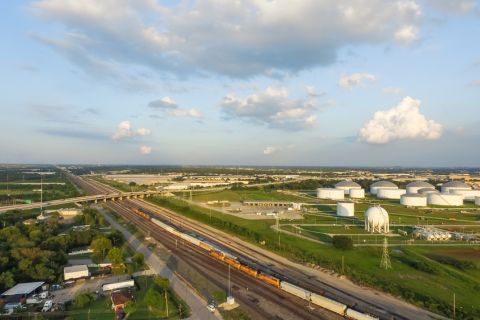
As the US basks in the glory of abundant shale gas supplies while operators await change to capitalize on the bounty, other countries hoping to tap such resources are struggling.
Frustrations are mounting in Poland as government officials work to halt an exodus of companies that are ditching exploration plans after poor initial results and downsized resource estimates.
The US Energy Information Administration estimated in 2011 that there was 187 Tcf of technically recoverable shale gas resources – the most in Europe; however, in 2012, Poland said recoverable reserves were between 12 Tcf and 27 Tcf.
But these numbers could change again. The Polish Geological Institute is expected to release a new resource assessment in 2014. Deloitte said the institute’s current shale estimate could increase by seven times due to an estimated 25% to 30% resource recovery based on new data.
“Currently, Poland’s shale gas industry is struggling to maintain international interest following a series of setbacks over the past year that threaten to push it from a nascent stage back to dormancy,” according to Deloitte’s Oil and Gas Reality Check 2013. “Over the short-term Poland will struggle to develop its nascent industry. While 111 exploration concessions were granted to nearly 30 companies, only some 33 test wells were completed with 10 hydraulically fractured, and the wells failed to yield commercial volumes of gas.”
In May Talisman Energy agreed to transfer its interests in Poland to San Leon Energy, opting to focus on its Americas and Asia-Pacific operations. Marathon Oil also departed after unsuccessful attempts to find commercial levels of hydrocarbons. Marathon is evaluating concession options for the assets valued at US $12 million.
ExxonMobil ended its shale gas exploration efforts in Poland in 2012.
Despite the situation, Poland still has its sight set on reaching commercial production by 2015 with plans for 270 new shale wells by 2020. Chevron and Eni are still exploring shale potential in Poland along with state-owned Polish Oil and Gas Co. (PGNiG), which according to the Poland Ministry of Treasury plans to drill 13 wells targeting shale gas this year.
A Poland Cabinet Committee was scheduled this week to discuss ways to lighten rules in an effort to quicken shale gas exploration and stave off more departures of E&P companies.
The regulations would allow companies to drill as deep as 5,000 m (16,404 ft) without all environmental permits required by existing laws, Bloomberg reported, citing Poland Environment Ministry spokesman Pawel Mikusek. Current rules mandate additional permits for deeper wells or directional changes while drilling.
Already, draft regulation regarding hydrocarbon extraction and taxation are moving through the legislative process. The regulations, which presume taxes and fees on companies will be capped at 40% of their gross profits, include a 3% royalty-style tax for unconventional oil deposits and 1.5% for gas as well as a 25% hydrocarbon tax on companies’ surplus of revenues over spending, according to a news release from the ministry.
Uncertainty over the tax laws also may be causing companies to assess or reassess plans.
Deloitte also noted in its report that Poland’s shale resources are one to two miles deeper than plays in the US, which adds to costs. “Although the country has slightly lower drilling times than US shale wells, a hydraulically fractured horizontal well in Poland costs nearly $15 [million] to $20 million.”
Moreover, the report pointed out another negative – a small services industry. Only five of the 15 drilling rigs are capable of drilling deep shale wells.
“It will be challenging for Poland to reach the incubator phase if new investments do not materialize or if drilling results do not improve,” the report said. “Even if the country were to begin commercial production of shale gas, the impact of its production on regional markets will be limited since it will likely use domestically produced gas to offset its high dependence on imported gas.”
Getting most of its imports from Russia, Poland consumes about 1.66 Bcf/d of natural gas, the report said.
As Poland works to tap its own shale resources, work progresses on meeting existing needs and gaining access to the global LNG market. Construction of Poland’s ?winouj?cie LNG terminal is nearly 60% complete, Polskie LNG said in a news release.
“The first contract for the supply of [LNG] from Qatar – signed between PGNiG and Qatargas – will guarantee the delivery of 1.5 Bcm of LNG annually during a period of 20 years from 2014,” the release said. “The facility’s initial regasification capacity is designed to amount to 5 Bcm, although the terminal is expected to expand its capacity up to 7.5 Bcm by means of construction of the third cryogenic tank, and this way to satisfy approximately 50% of the current annual demand for gas in Poland.”
Contact the author, Velda Addison, at vaddison@hartenergy.com.
Recommended Reading
Midstream Operators See Strong NGL Performance in Q4
2024-02-20 - Export demand drives a record fourth quarter as companies including Enterprise Products Partners, MPLX and Williams look to expand in the NGL market.
Enbridge Sells Off NGL Pipeline, Assets to Pembina for $2.9B
2024-04-01 - With its deal to buy Enbridge’s NGL assets closed, Canada's Pembina Pipeline raised EBITDA guidance for 2024.
Pembina Pipeline Enters Ethane-Supply Agreement, Slow Walks LNG Project
2024-02-26 - Canadian midstream company Pembina Pipeline also said it would hold off on new LNG terminal decision in a fourth quarter earnings call.
Williams Beats 2023 Expectations, Touts Natgas Infrastructure Additions
2024-02-14 - Williams to continue developing natural gas infrastructure in 2024 with growth capex expected to top $1.45 billion.
Report: Crescent Midstream Exploring $1.3B Sale
2024-04-23 - Sources say another company is considering $1.3B acquisition for Crescent Midstream’s facilities and pipelines focused on Louisiana and the Gulf of Mexico.





